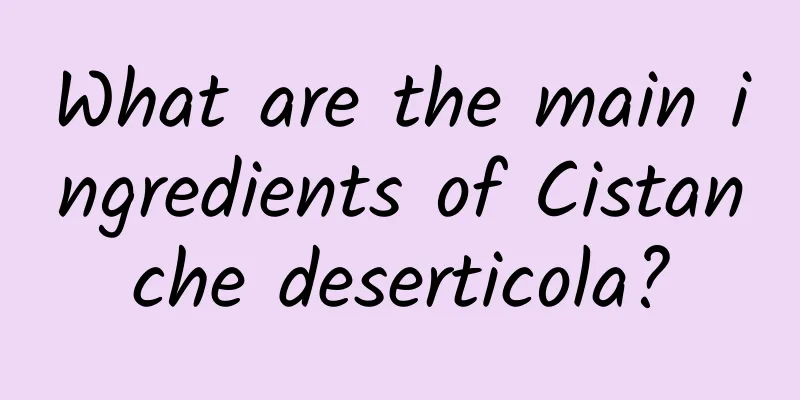What are the main ingredients of Cistanche deserticola?

|
Many people do not know the main ingredients of a certain food when they eat it. This is wrong. Only when we figure out the main ingredients of the food can we understand whether we are suitable for eating this food. There are many main ingredients in Cistanche. Although it is impossible to list them one by one, if you want to know more, you can check relevant books. Next, let us learn about what the main ingredients of Cistanche are? Cistanche deserticola Ma (scientific name: Cistanche deserticola Ma), also known as Xinjiang Yun, Cun Yun, Cistanche, and Chagan Gaoya (Mongolian), is an endangered species. Tall herbs, 40-160 cm tall, mostly underground. The flowering period is from May to June, and the fruiting period is from June to August. It is mainly produced in Xinjiang and Alxa League of Inner Mongolia, and is also distributed in Gansu and Ningxia. Cistanche deserticola is a parasitic plant that lives on the roots of the desert tree Haloxylon ammodendron, absorbing nutrients and water from its host. It is known as the "desert ginseng" and has extremely high medicinal value. It is a traditional precious Chinese medicinal material. In history, Cistanche deserticola has been regarded as a precious tribute to the imperial court by the Western Regions. It is also one of the most frequently used tonic medicines in kidney-tonifying and yang-strengthening prescriptions throughout the ages. Every April, Cistanche and Cynomorium songaricum enter their peak growth period, which is also the peak period for illegal digging and mining by lawbreakers. Driven by economic interests, some lawbreakers even do not hesitate to obstruct law enforcement and come into direct conflict with law enforcement officers. The stem is unbranched or has 2-4 branches from the base, with a diameter of 5-10(-15) cm at the lower part, gradually becoming thinner upwards to 2-5 cm in diameter. The leaves are broadly ovate or triangular-ovate, 0.5-1.5 cm long and 1-2 cm wide, densely grown at the bottom of the stem and sparsely and narrowly grown at the top, lanceolate or narrowly lanceolate, 2-4 cm long and 0.5-1 cm wide, glabrous on both sides. Inflorescence spike-shaped, 15-50 cm long, 4-7 cm in diameter; bracts in the lower half or all of the inflorescence are longer, equal to or slightly longer than the corolla, ovate-lanceolate, lanceolate or linear-lanceolate, together with the bracteoles and corolla lobes, sparsely pubescent or nearly glabrous on the outside and edges; bracteoles 2, ovate-lanceolate or lanceolate, equal to or slightly longer than the calyx. The calyx is bell-shaped, 1-1.5 cm long, with 5 shallow lobes at the top, and the lobes are nearly round, 2.5-4 mm long and 3-5 mm wide. The corolla is tubular and bell-shaped, 3-4 cm long, with 5 lobes at the apex. The lobes are nearly semicircular, 4-6 mm long, 0.6-1 cm wide, and the edges are often slightly rolled outward. The color varies, from light yellowish white or lavender, and often turns brown after drying. There are 4 stamens, and the filaments are inserted 5-6 mm from the base of the tube, 1.5-2.5 cm long, with wrinkled and long soft hairs at the base. The anthers are long ovate, 3.5-4.5 mm long, densely covered with long soft hairs, and have a cusp at the base. The ovary is oval, about 1 cm long, with nectar glands at the base. The style is slightly longer than the stamens, glabrous, and the stigma is nearly spherical. The capsule is ovoid, 1.5-2.7 cm long and 1.3-1.4 cm in diameter, with a persistent style at the top and 2-petal dehiscence. The seeds are elliptical or nearly ovate, about 0.6-1 mm long, reticulate and shiny on the outside. The flowering period is from May to June, and the fruiting period is from June to August. The above introduces the main ingredients of Cistanche. Although many substances are unknown to us, it is still necessary for us to understand them. Of course, there are many ways to eat Cistanche, so you can also spend more time and energy on this aspect, then you can enjoy the deliciousness that Cistanche brings you and have a healthy body. |
<<: What are the contraindications of taking Panax notoginseng?
>>: How many types of Cistanche are there?
Recommend
This is cauliflower, this is not cauliflower, netizens: I just want to know if I can eat it
Is this dish edible? Boil water It’s time to eat ...
The efficacy and function of the root of Ligusticum chuanxiong
The root of the ophiopogon japonicus is a common ...
C919 opens a new route again. How can a tiny aviation tire carry a plane weighing hundreds of tons?
□ Don't respect the principle of becoming a g...
The efficacy and function of iron tree
Diseases require improvement through medicine. Di...
Rural people eat so much that they want to vomit, while city people want to eat but cannot buy it
Mud mustard greens is a wild forage grass that gr...
The efficacy and function of Grebe
After thousands of years of sedimentation and acc...
Why can roosters crow on time? Does it have an alarm clock inside its body?
This question seems a bit ridiculous, because the...
What you think is "getting angry" may be a warning sign of cancer! Don't just bear these 4 symptoms if they don't heal for a long time
Ms. Wang, 30 years old, has recently had frequent...
How good are the Chinese at planting trees?
The reporter learned from the National Forestry a...
The distribution map of Chinese surnames has been released. Let’s see where your roots are.
It is estimated that 87% of China's populatio...
Beware of flash floods! Two departments jointly issue orange flash flood disaster weather warning
The Ministry of Water Resources and the China Met...
Sharing some tips on how to make wine with antler antlers
In today's high-pressure modern world, it is ...
Do plants know math? The magical Fibonacci sequence
Editor's note: Plants occupy a very important...
Flu ≠ cold! Don’t confuse them anymore! You must know these differences →
Although medicine has made great progress in the ...
Bring your own antidote and not be afraid of toxins: How did poison frogs and pufferfish become “poison masters”?
There are so many poisonous animals in nature. Ha...









